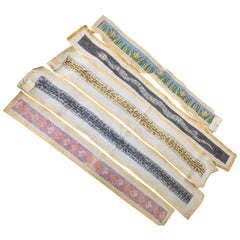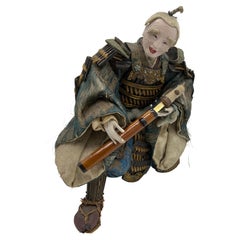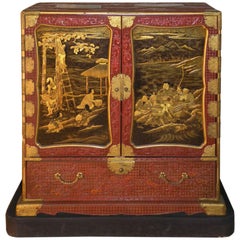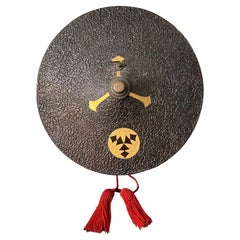Textile Antiquities
to
1
1
1
2
1
1
1
1
1
5,650
700
542
490
282
1
1
1
1
1
2
2
2
1
Material: Textile
Lou Gartner Needlepoint Blanks, Belts/Straps
By Lou Gartner
Located in Riverdale, NY
Hand painted Lou Gartner Needlepoint Blanks, Belts/Straps from the 1960s-70s from his estate. The longer ones are likely belts or pulls and the shorter one...
Category
1970s American Mid-Century Modern Vintage Textile Antiquities
Materials
Textile
$185 / item
Japanese Samurai Figure Hinaningyo, Edo Period
Located in Munich, Bavaria
Antique samurai doll called Hinaningyo; Japan, late EDO period
Praised at the Tang-no-sekku boys' festival on May 5th as a sign of bravery, embodying the...
Category
Mid-18th Century Japanese Antique Textile Antiquities
Materials
Textile, Wood
$2,710 Sale Price
20% Off
Related Items
Japanese Lacquer and Cinnabar "Samurai" Cabinet, Inaba Family, Edo Period
Located in Troy, NY
Exceptionally large and rare lacquer cabinet. According to the heraldry, visible on the headgear in one of the panels, it was made for the Inaba family, a high ranking Daimyo family,...
Category
Late 19th Century Japanese Edo Antique Textile Antiquities
Materials
Wood
$385,000
H 38 in W 36 in D 21 in
Japanese Lacquered Samurai Jingasa Hat Edo Period
Located in Atlanta, GA
A bespoken Japanese historical hat known as Jinggasa (militant hat) that was worn by samurai in Edo period (1603-1868) circa 18-19th century. There were several subtypes of Jingasa a...
Category
19th Century Japanese Japonisme Antique Textile Antiquities
Materials
Wood, Lacquer
19th century Edo-period Japanese Hanging Scroll Calligraphy of Mad Poetry
Located in Chiba, JP
Hanging scroll with such unstrained and refined calligraphy of ‘Kyoka’ (lit. ‘Mad poetry’ – Humorous style of Japanese tanka poetry with joke or irony or satire) by a late Edo-period...
Category
19th Century Japanese Edo Antique Textile Antiquities
Materials
Brocade, Wood, Paper
$500
H 71.46 in W 13.78 in D 1.38 in
Satsuma Earthenware Vase and Cover, Japanese, Meiji Period
By Satsuma
Located in West Palm Beach, FL
A Satsuma Earthenware vase and cover,
Japanese, Meiji period, (1868-1912)
decorated in polychrome enamels and gilt over a clear, crackled glaze, delicately painted with samurai on ...
Category
1890s Antique Textile Antiquities
Materials
Ceramic
Japanese Half Kimono Belt Hanhaba Obi Sky Blue with Rose 1980s
Located in Paris, FR
This is a Japanese beautiful Kimono belt called 'Han haba obi'.
Both side are with motifs but different motifs. It is a belt for kimono but you can use as a table runner or wall deco...
Category
1980s Japanese Showa Vintage Textile Antiquities
Materials
Silk
Japanese Red Samurai Armour Beginning of Meiji period 1900s
Located in Paris, FR
This is an armour of samurai. It was made around 1900s in Meiji era. This armour was not used in actual war so it was made as decoration, because of that, it is in good condition as its age.
There are some scratches and missing parts, if you need some more information, please let us know, we will respond you as soon as possible and send more photos.
This armour can be folded in a box. The box is getting damaged so it is not in good condition. We might send this armour in other box.
Dimensions: 50 x 50 x H170 cm
Scholars agree that Japanese armour first appeared in the 4th century, with the discovery of the cuirass and basic helmets in graves. During the Heian period, the unique Japanese samurai...
Category
Early 1900s Japanese Meiji Antique Textile Antiquities
Materials
Metal, Iron
Antique Small Chest of Drawers from Edo period 19th Century, Japan
Located in Tokyo, Tokyo
Antique small chest of drawers from Edo period (1603-1868), Japan.
If you look closely at the top surface, you can see writing on it.
...
Category
19th Century Japanese Antique Textile Antiquities
Materials
Iron
$600
H 7.68 in W 10.24 in D 15.56 in
Japanese Antique Combat Helmet 'Kabuto' 1800s Edo Era
Located in Paris, FR
This is an antique combat helmet made around 1800s in Edo era in Japan.
Kabuto is a type of helmet first used by ancient Japanese warriors which, in later periods, became an important part of the traditional Japanese armour...
Category
Early 19th Century Japanese Antique Textile Antiquities
Materials
Iron
Antique Silk Japanese Kimono Belt, 1970s
Located in Paris, FR
This is a Hitoe Obi made in Japan around 1970s.
Obi is a belt of varying size and shape worn with both traditional Japanese clothing like Kimono....
Category
Late 20th Century Japanese Showa Textile Antiquities
Materials
Silk
Samuraï armor
Located in Brussel, BE
Amazing and unique Samuraï armor.
End of XIXth century, early XXth century.
Nimai do Okegawa gusoku (2 plate with barrel form cuirasse armor).
Composed o...
Category
Late 19th Century Japanese Japonisme Antique Textile Antiquities
Materials
Iron
Extremely Rare Tokugawa Clan Kimono Hanger with Maki-e Lacquer. Edo period
Located in Fukuoka, JP
Extremely Rare Tokugawa Clan Kimono Hanger with Makie Lacquer and Gilded Fittings
Edo Period, 18th–19th Century Dimensions: H 166 cm × L 187 cm × W 41.5 cm Materials: Wood, Lacquer...
Category
18th Century Japanese Edo Antique Textile Antiquities
Materials
Metal
$13,500
H 65.36 in W 16.34 in D 73.63 in
A Japanese Samurai ressei menpo mask
Located in Milano, IT
Samurai menpo mask with the ressei (fierce) expression, belonging to the me-no-shita "half-face" type, which stands out for its leather surface to simulate ...
Category
18th Century Japanese Japonisme Antique Textile Antiquities
Materials
Leather
Recently Viewed
View AllMore Ways To Browse
Large Chinese Celadon Pots
Khmer Torso
Ancient Luristan Bronze
Chinese Terracotta Army Warriors
Cloisonne Pots Bonsai Trees
Greco Bactrian
Han Dynasty Amphora
Han Dynasty Court Lady
Palanquin Handles
Sancai Phoenix
Schist Gandharan Buddha
Bactrian Stone
Chinese Coconut Cup
Han Dynasty Chinese Cocoon Jar
Han Dynasty Cocoon Jars
Han Dynasty Pig
Khmer Goddess
Kojima Shoten



